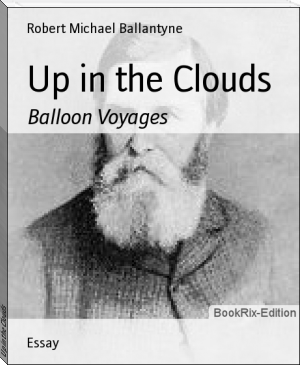Up in the Clouds by Robert Michael Ballantyne (most important books to read txt) 📖

- Author: Robert Michael Ballantyne
Book online «Up in the Clouds by Robert Michael Ballantyne (most important books to read txt) 📖». Author Robert Michael Ballantyne
Stephen devoted himself chiefly to the study of mathematics, Joseph to chemistry; and they were accustomed to form their plans in concert. It appears that they had long contemplated, with philosophical interest, the floating and ascent of clouds in the air, and when they heard of or read Cavendish's theories in regard to _different kinds of air_, it at once struck them that by enclosing some gas lighter than the atmosphere in a bag, a weight might be raised from the earth into the air.
The brothers Montgolfier were men of that vigorous stamp who act promptly on receiving their convictions. At once they set about experimenting, and constructed large bags of paper,--the substance which naturally came readiest to their hands, and which appeared to them to be best suited to their purpose. These were filled with hydrogen gas, which raised them to the ceiling; but, owing to the escape of the gas through the pores and cracks of the case, those embryo balloons descended in a few minutes. Instead of varnishing the paper to prevent the escape of the gas, and supposing, erroneously, that the fault lay in the latter, they sought about for a new gas more suitable to the paper. This they found, as they supposed, in the gas which resulted from the combustion of wet straw and wool, which had an upward tendency, they thought, on account of its electrical properties, which caused it to be repelled from the ground. It is scarcely necessary now to point out that the true cause of the upward tendency lay in the rarefaction of the air by the heat of the fire, and that hot air has a tendency to rise because its bulk is greatly increased beyond the same quantity of the surrounding cold air.
Although wrong in assigning the cause of the result, they were right in the application of it. While on a visit to Avignon Joseph Montgolfier procured a silk bag having a small opening at its lower end, and a capacity of about fifty cubic feet. Under the orifice some paper was burnt; the air inside was heated and expanded so as to fill the bag, which, when let go, soared rapidly up to the height of seventy or eighty feet, where it remained until the air cooled and allowed it to descend. Thus did the _first_ balloon ascend in the month of November 1782.
Delighted with their success, the indefatigable brothers resolved to make further experiment on a larger scale. They procured a quantity of packcloth or coarse linen, formed it into a globe about ninety feet in circumference, lined it with paper, and lighted a fire under it in an iron choffer. This balloon went up with a force which they estimated as equivalent to 500 pounds.
After this the Montgolfiers appeared to have become ambitious of accomplishing greater things, and giving to their discoveries publicity; for we are told that, "they invited the members of the provincial meeting of the states of the Vivarais, then assembled at Annonay, to witness the first _public_ aerial ascent. On the 5th June 1783, amidst a very large concourse of spectators, the spherical bag or balloon, consisting of different pieces of linen, merely buttoned together, was suspended from cross poles. Two men kindled a fire under it, and kept feeding the flame with small bundles of chopped straw. The loose bag gradually swelled, assuming a graceful form, and in the space of five minutes it was completely distended, and made such an effort to escape that eight men were required to hold it down.
"On a signal being given the stays were slipped, and the balloon instantly rose with an accelerating motion till it reached some height, when its velocity continued uniform, and carried it to an elevation of more than a mile. All was admiration and transport. Amidst the shouts of unbounded applause, the progress of the artificial cloud retiring from sight arrested every eye. It was hurried along by the wind; but its buoyant force being soon spent, it remained suspended only ten minutes, and fell gently in a vineyard at a distance of about a mile and a half from the place of its ascension. So memorable a feat lighted up the glow of national vanity, and the two Montgolfiers were hailed and exalted by the spontaneous impulse of their fellow-citizens."
This event created a sensation not only in France but over the whole of Europe. In Paris, particularly, the effect on all classes was so great that they determined to have the experiment repeated, set a subscription on foot, and appointed a scientific man named Charles, and two brothers of the name of Robert, to construct a balloon. This they did, but instead of applying the Montgolfier motive power--heated air--they used hydrogen gas, procured by the action of diluted sulphuric acid upon iron filings. Their balloon, which was made of thin silk, varnished with a solution of elastic gum, was a much nearer approach to the balloon of modern days than that of Montgolfier. It was a great success; it rose and remained suspended at a height of 100 feet, in which state it was conveyed with acclamation to the Place des Victoires, where it rested and underwent some repairs. At midnight it was conveyed in solemn procession by torchlight, and guarded by a detachment of horse, to the Champ de Mars, where, on the following day, the whole world of Paris turned out to witness another ascent. The balloon went up to the sound of cannon, and in two minutes reached a height of 3000 feet, when it was lost for a time in a dark cloud, but speedily reappeared still higher. After a flight of fifteen miles, performed in three-quarters of an hour, it sunk to the ground in a field near Ecouen, where it was secured by the peasants.
The Parisians now appeared to become balloon-mad. The Royal Academy of Sciences invited Joseph Montgolfier to repeat his experiments, and another balloon was prepared by him of coarse linen with a paper lining, which, however, was destroyed by incessant and violent rain before it could be tried. Undeterred by this, another was constructed by him, which ascended from Versailles on the 19th of September 1783.
This balloon deserves peculiar notice as being the first which carried up living creatures. A sheep, a cockerel, and a duck, were the first aeronauts! They ascended to a height of about 1500 feet; remained suspended for a time, and descended some two miles off in perfect safety--indeed we may say in perfect comfort, for the sheep was discovered to be quietly feeding when it returned to the earth!
The practicability of ballooning being now fairly established, men soon began to venture their own persons in the frail cars. A young and enthusiastic naturalist named Rozier leaped into the car of another of Montgolfier's balloons soon after this, and ascended in safety to an elevation of about 300 feet, but on this occasion the balloon was held down by ropes. The ice, however, was broken, and bolder attempts quickly followed.
CHAPTER THREE.
EARLY ATTEMPTS AT AERIAL NAVIGATION.
The first free and unfettered balloon voyage was performed very soon after the event mentioned at the end of the last chapter. It was a daring attempt, and attended with great danger.
A balloon made by Montgolfier was used. It was 75 feet high, 45 feet wide, and spheroidal in form--heated air being the motive power. The bold aeronauts, on this occasion, were the naturalist Rozier and the Marquis d'Arlandes, a major of infantry. From the gardens of the Chateau of Muetta they ascended on the 21st November 1783.
In the car there was a quantity of ballast, and a provision of straw to feed the fire. The balloon mounted at first with a majestic steady motion, gazed at in breathless wonder by thousands of spectators, who assembled not only in the neighbourhood of the Chateau, but clustered on every point of vantage in Paris.
When the daring voyagers reached a considerable height, they took off their hats and waved them to their friends below, and the multitude-- realising, perhaps, that that which in former ages had been deemed the dream of visionaries, was at last an accomplished fact--responded with enthusiastic acclamations until the balloon passed upwards through the clouds and was lost to view.
It would seem that these first aeronauts were of different temperaments; for, after they had reached a height of nearly 3000 feet, and the earth was no longer distinguishable, the Marquis began to think that he had seen enough of the upper regions, would fain have descended, and murmured against his companion, who still kept feeding the fire. Apparently his alarm was justifiable, for Rozier continued recklessly to heap on fuel, until he almost set the balloon on fire. On hearing some cracks from the top, and observing some holes burning in its sides, the Marquis became so alarmed that he compelled his companion to desist, and with wet sponges stopped the conflagration, which had actually begun.
When the fire diminished, however, the balloon began to descend much quicker than was safe or agreeable, and the marquis himself began to throw fresh straw on the fire to enable them to clear the roofs of Paris. This they did very dexterously, considering that they were so unaccustomed to such navigation, throwing on just as much fuel as was sufficient for the purpose, and keeping clear of steeples and chimneys until they alighted in safety beyond the Boulevards. Their voyage lasted about half-an-hour, and they described a track of six miles around Paris, having ascended to a height of 3000 feet.
Thus was the first balloon voyage successfully accomplished by the French; and the Montgolfiers, besides enjoying the triumph which their persevering efforts deserved, were awarded the annual prize--six hundred livres--of the Academy of Sciences. The elder brother was invited to Court, decorated with the badge of Saint Michael, and received a patent of nobility; while the younger received a pension and a sum of forty thousand livres wherewith to prosecute his experiments with balloons.
The great success of the Montgolfier balloons naturally threw the efforts of Monsieur Charles and the brothers Robert into the shade. Nevertheless those gentlemen had got hold of a better principle than their rivals; and, knowing this, they resolved to convince the sceptical by constructing another balloon. They wisely began by obtaining subscriptions to enable them to carry out their designs, and finally succeeded in making a globe formed of tiffany, covered with elastic varnish, which was twenty-eight feet in diameter. This they filled with hydrogen gas. Some idea of their difficulties and expenses may be gathered from the fact that the mere filling of the balloon required an apparatus which cost about 400 pounds sterling, one-half of which was expended on the production of the gas alone.
The ascent of this balloon deserves to be regarded with special interest, because, besides being the first _hydrogen_ balloon which carried up human beings, it was the first





Comments (0)